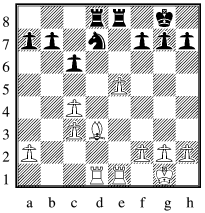
March 2014
Division 1
| ||||||||||||||||||||||||||||||||||||||||||||||||
Division 3
| ||||||||||||||||||||||||||||||||||||||||||||||||
Division 5
|
Division 2
| ||||||||||||||||||||||||||||||||||||||||||||||||||||||
Division 4
|
Macclesfield lost their first league match of the season, but with Knights also losing against clubmates Rooks, this has not affected Macclesfield's favourite's status. At the bottom of the table Alsager and Fenton are now definitely adrift in a private battle to avoid propping up the division. February was not a good month for postponements in this division, with Fenton A v Rooks, Cheddleton C v Macclesfield, Cheddleton D v Fenton A and (apparently) Knights v Macclesfield all called off. The first three do though all have new dates in March already arranged.
The third division suffered its first postponement of the season when Meir A were unable to take a team to Cheddleton E. All teams in the division picked up points during February, with the net result being little change in positions but fewer games left for anyone to jump out of the pack to challenge the Cheddleton E - Kidsgrove duopoly.
Fenton B continue to dominate in division four to such an extent that the major interest in the division is now in who will be victorious in the scramble for second, with the teams apparently best placed still having a match each against Fenton to negotiate.
The age old question, would you rather have points on the board or games in hand, applies in division five. Meir D appear to have built up a healthy lead, but have played more games than their rivals. Will their lead be enough?
Plenty of cup action in February. In the open cup semi-finals Stafford and Cheddleton beat Newcastle and Holmes Chapel respectively. The Intermediate cup saw Cheddleton beat Alsager in a delayed first round match before losing to Newcastle, who will now host Kidsgrove in the final, the latter having beaten Meir. Cheddleton and Fenton reached the Perry final by beating Meir and Newcastle respectively. Fenton who had needed elimination to beat Alsager earlier had an easier time of it in the semi-final - they only needed board count to get past Newcastle.
Rob Shaw and Malcolm Armstrong shared the spoils in the third GP event, though Alex Richardson and Dave Buxton also retain serious interest with them in the overall title.
comment on this article
With reference to the report above, Knights and Macclesfield did play their division two game with Macclesfield winning, giving them a stranglehold on the division.
I've now completed February by adding the games I played at West Bromwich late in the month.

|
| Sam Beardmore v RR after 15 ... Rfe8 |
We all know the schoolboy "What's yellow and dangerous?" joke. Is there anything lurking beneath the surface of this apparently innocuous position? Sam goes for more piece exchanges - his kingside majority should surely prevail in a pieceless ending.
16 Bf5 Nxe5 A small shark.
17 Rxd8 Rxd8, 18 Rxe5 is not available to white because of the back row mate. RR has material equality.
17 c5 (Rd4 is not a good idea)
17 ... g6, 18 Bc2 diagram right
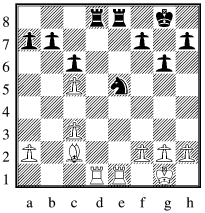
|
| Sam Beardmore v RR after 18 Bc2 |
18 ... Rxd1, 19 Bxd1 (add question marks to taste, two probably aren't enough)
19 ... Nf3+, 20 gxf3 Rxe1+, 21 Kg2 Rxd1
RR is a rook up in an otherwise pieceless ending. Although Sam played on to mate, I don't think any of the spectators now had any doubts over the final result.
comment on this article
But I suspect the biggest killer is impatience, giving rise to ill-considered moves which are either directly losing or have to be retracted later losing tempi. That was RR's lot in todays game against Mike Hancock. We join the game for RR's eleventh move, Mike having just completed his development.
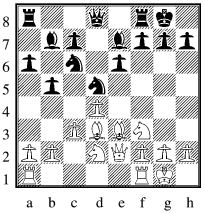
|
| Mike Hancock v RR after 11 Nbd2 |
But I'm too keen to make some obvious (to me) even if simple threat, so
11 ... f5, 12 Nb3 He saw the threat against the bishop
12 ... f4 Compounding the error. At least on f5 the pawn was keeping the white squared bishop away from the kingside.
12 ... Nxe3, 13 Qxe3 Qd5 and I've killed one bishop and am temporarily at least controlling the other. But this impatient push to f4 leaves all sorts of weaknesses. Not the least of future problems is that I won't have the useful Nf6 defensive move without blocking the defence of the f-pawn.
13 Bd2 Although I've dropped no material, and there is no immediate mating threat, I suspect this position is already lost. For the time being, my immediate task is clear. defend that e-pawn.
13 ... Qd7, 14 Rfe1 Bc8 (... Rf6, 15 Ng5 forks the e- and h-pawns.) Will my a-rook ever get into the game?
15 Be4 h6, 16 Rad1 Bd6, 17 c4 bxc4, 18 Qxc4 Nce7
19 Nc5 Bxc5 offering to exchange queens with Qb5 better
20 dxc5 Qb5, 21 Qc2 Rb8, 22 b3 diagram right

|
| Mike Hancock v RR after 22 b3 |
22 ... Rf6, 23 Bc3 Rf8 Desperately trying to retain material equality, but giving up the exchange for the c-pawn may well be sounder. At least I saw that Nxc3 would be a disaster:
23 ... Nxc3, 24 Rd8+ Rf8 (... Kf6, 25 Ne5#), 25 Bh7+ and the black king is hounded to death. However I've wasted two moves with the rook going nowhere whilst he gets his bishop on the long diagonal.
24 Ba1 Nf6 The f6 square has a fatal attraction for RR which speeds up his demise.
25 Bxf6 gxf6 not Rxf6 for reasons we've just discussed
26 Bd5 Yuk. I can't take and allow his rook to the seventh, whilst ignoring and allowing the loss of the e-pawn just allows him to gain momentum. Choice of resigns or see if I can survive the line starting
26 ... Nxd5, 27 Qg6+. I didn't resign, and I didn't survive the attack. 1-0
Whilst I am not proud of some of moves later in the game there is no doubt in my mind that the real culprits were f5 and particularly the subsequent f4. Against any decent player these will leave me scrabbling around vainly looking for ways of coping with the weaknesses created. And Mike is rather more than decent.
comment on this article
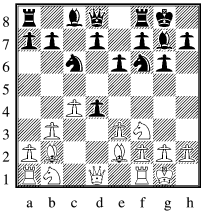
|
| RR v Phil Birks after 8 ... cxd4 |
13 Qb3 Qc7, 14 Nd2 Rb8, 15 Qc2 Rd8 Natural, but slow. Black can play c5 immediately.
16 Nf3 RR knows what is likely to be happening - c5 - resulting in him ending up with an isolated c-pawn, yet he sets up his defence incorrectly. Yes, it may be normal to want the extra safety of another piece near his king, but Nb3 would have made it harder for black to play c5, with the added bonus of closing the b-file for a while. Indeed after Nb3 the game takes a different course, with white having time for Rad1 and Bc3. 16 ... c5, 17 dxc5 (right)
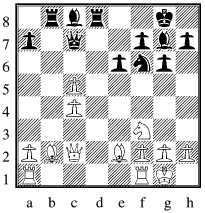
|
| RR v Phil Birks after 17 dxc5 |
17 ... Nd7, 18 Bxg7 Kxg7, 19 h4 deciding that the best way to slow threats against the c-pawn is to make ones against the king. Not true. The considered and rejected c6 is preferable, though was rejected because I couldn't see what it achieved. Answer: by pulling the queen onto c6 a) it no longer covers e5, and b) to some extent it may get in the way of his bishop. How often do we find that subtle moves like that are better than crude attacking threats? So we now enter a phase of the game in which RR appears to call the tune, but Phil has potentially the better endgame.
19 ... h5 Advancing pawns against an attack can work against the defender as it gives readily accessible targets. Should I play Ng5 with threat of Bxh5? No. While he may not wish to play Nf6 to stop this threat for fear of the knight becoming permanently pinned, do I have a mate anyway after Nxc5 and his then accepting the bishop sac? Don't think so.
20 Rfd1 Qxc5, Nxc5 better - the knight makes a better blockader, and black doesn't hve the problem of worrying about the pin.
21 Rd4 Mistimed and misplayed. Having decided that the bishop sac trick leads nowhere RR should have turned his attention to pressurising the weak black squares, so Qc3+. Further if he wishes to gang along the d-file Rd2 better as the rook there is free from harrassment.
21 ... Re8, 22 Rad1 Nf6, 23 Ng5 Rb7, 24 Qc3 e5, 25 Rd6 Bf5
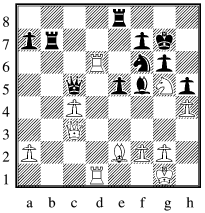
|
| RR v Phil Birks after 25 ... Bf5 |
26 Bf3 Not proud of this either, but Phil unlikely to want to push the f-pawn, pinning his knight to the king and exposing the queen to sideways attack by rooks. Guess his f-pawn is pinned against a pin.
26 ... Rc7, 27 Ra6 rather than defending with Be2, RR decides to take his chances with an outside passed pawn.
27 ... Qxc4 Ng4 first would have been annoying
28 Qxc4 Rxc4, 29 Rxa7 Be6, 30 Be2 Rd4 diagram right
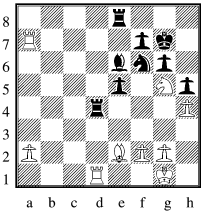
|
| RR v Phil Birks after 30 ... Rd4 |
31 Nxe6+ Rxe6, 32 Rxd4 exd4, 33 Bc4 (Kf1 please!)
33 ... Rd6 why I'd left him the option of Re1+ and Ng4+ I know not, but Phil went for the rooks support pawns from behind line.
34 Rxf7+ Kh8, 35 Bd3 Kf1 stronger, as it brings the king in to play. However the twin threats of the outside passed pawn and winning more pawns on the kingside should be decisive as his d-pawn is well under control.
35 ... Re6, 36 Kf1 Ne4, 37 Rc7 Nc3, 38 a3 Rd6, 39 Rc4 Kg7
40 a4 Kf6, 41 a5 Ke5, 42 Rc5+ Kf6, 43 a6 Nd5, 44 a7 Rd8, 45 Rxd5 1-0
comment on this article